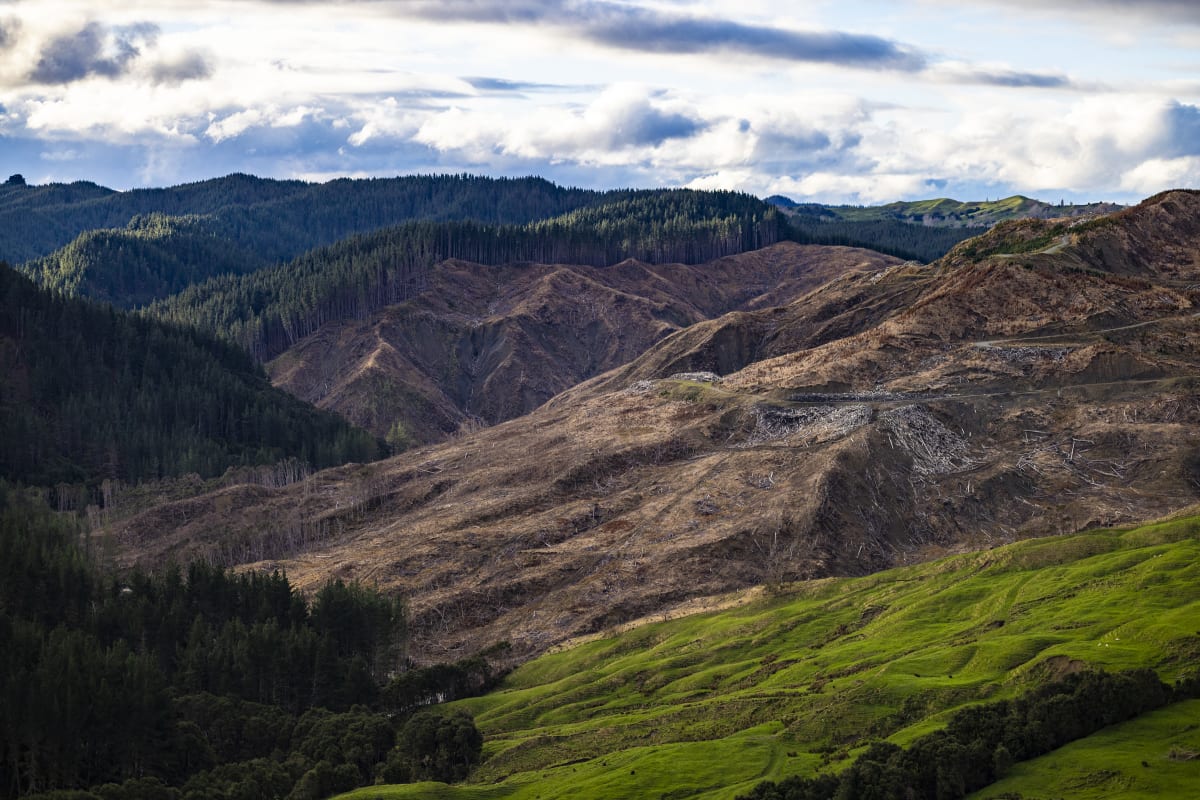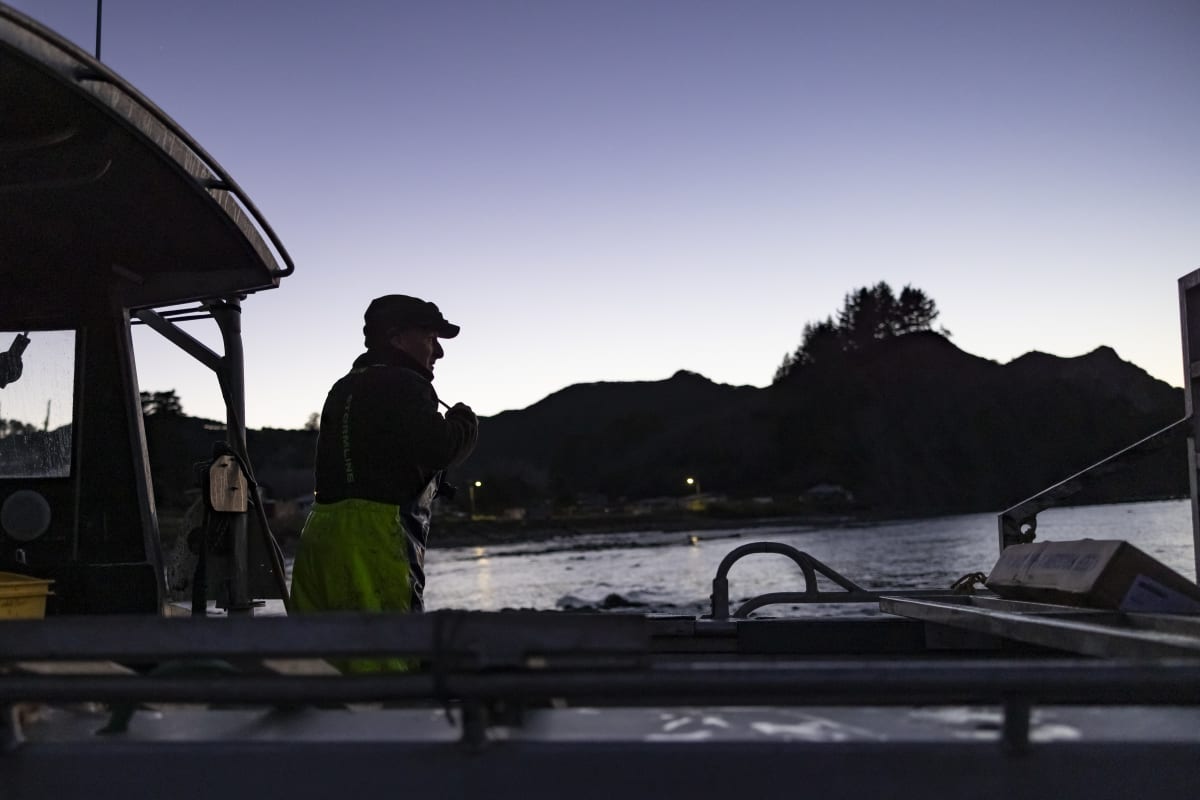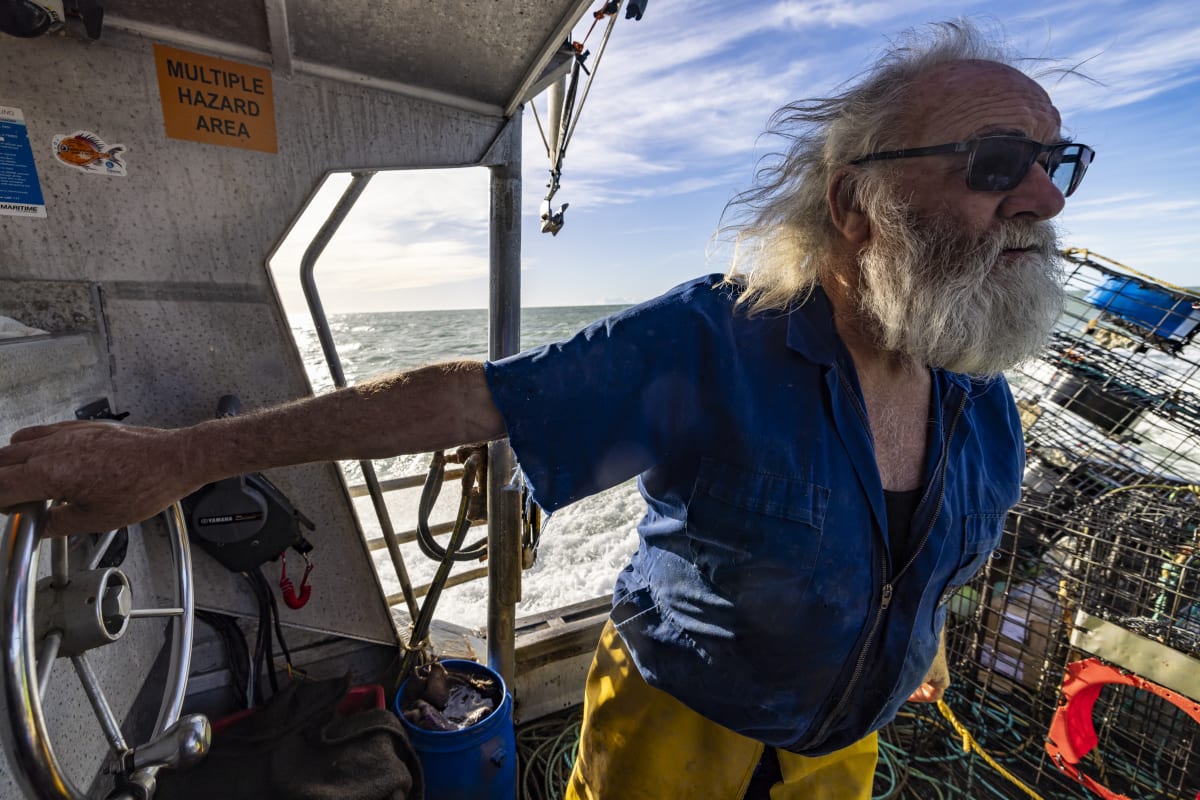It’s been known for over a century that the East Coast was vulnerable to erosion. But over that time decisions have been made that have continued to make it worse and now it’s at a catastrophic turning point that could decide the future of the region. Aaron Smale continues a series on the slow destruction of Tairāwhiti.
It’s like stepping back into a 1970s childhood. Wal from Footrot Flats would feel at home. There’s a neat row of redband gumboots outside the door of the Four Square General Store in Toko. The all-purpose footwear are handy when negotiating water and silt and also easy to get on and off when going indoors. The Four Square is bigger than your average dairy but smaller than a supermarket.
Heading through the carpark there’s a couple of locals chewing the fat leaning against a Toyota Hilux, a later model than the original that Barry Crump made a must-have in the regions. It’s a must-have around here, not because of any clever marketing but because State Highway 35 is buggered, to borrow another Toyota ad.
READ MORE: * Part one: The colonial cul-de-sac: Land loss, land use and the devastation left behind
It’s not just the roads either. Within earshot a comment is overheard: “Toko’s f****d bro” one says emphatically, not expecting any debate on the matter.
I might as well go home. There’s the story in three words. But there are plenty of others who agree with that conclusion not only about Tokomaru Bay but about the entire Tairāwhiti region. And they’ve got more than three words to say about it. Ngāti Pōrou have a reputation for being voluble.
The aroma of baked pastry wafts down the road, evidence of a local delicacy neither Wal nor Barry knew in their day – Cafe 35’s paua pies. It might sound like a bad idea until you sink your teeth through the pastry into a creamy filling that is a thing of wonder. The cafe has diversified and now has pork belly pies as its latest offering. They’re products that know their market, which going by the prevalence of fluro vests and work boots, is mainly logging truck drivers and roading contractors.
A couple of them are chowing down on pies and sipping flat whites, while discussing the finer points of logistics and installing culverts. One not-very-smart dog nearby barks every time a logging truck goes by. Which is like every second vehicle.
One of the contractors has an elaborate ta moko over the entirety of his head where his hair should be. When I say I’m catching up with Lillian Ward he cocks his eyebrow, as if to say, you might be here a while. He’s her partner, Haz.

It’s immediately obvious that Lillian is one of those boss wāhine, get-shit-done people who run the coast. She stands in a long line of Ngāti Pōrou women who have led their people over generations. Tokomaru Bay’s hapū, Te Whānau a Ruataupare, is named after one such wahine. There are others like Hinerupe in Te Araroa.
Lately there’s quite a bit to get done. The road had only just opened six weeks after Cyclone Gabrielle wrecked a bridge to the south and piled up a landslide over SH35 heading north.
Over that time Lillian was coordinating the logistics of getting in supplies and communicating with services outside the bay.
“I’m Civil Defence lead within Tokomaru Bay. Actually thrown into it. Initially, didn't know what we were doing, learn as we go. But it's all around responding and keeping our whānau safe during civil defence emergencies. We have an awesome team of volunteers who stand up and give their time freely. If I look at Gabrielle, we were doing 20-hour days over a four-week period. No tapping out, there was no one to come in and give us a rest. So we carried on doing what we needed to do until the risk to our whānau was no longer there.
“We had slips on the Mangahauini River that had caused a big huge dam. And behind the slip was a build-up of slash. We were told that there's only a 70 percent chance that that dam would break. As community volunteers 70 percent was too much of a risk for us to leave our whānau who live along Mangahauini River in their home so I think we evacuated whānau three times over Gabrielle. Very unsettling. Now when we have any weather events, whānau have high levels of anxiety and experience panic attacks. So when we ask them to prepare, they can't get into preparation mode because they're worried about survival.”
But Ward’s priority focus on people means she also has a few things to say about how the damage to the environment is harming whānau. The two can’t be separated. Any conversation about Gabrielle or any of the half dozen storms that have hit the coast in the past year is inevitably coupled with mention of slash, the off-cuts and debris from the harvesting of pine forestry. The floodwaters that have hit Tairawhiti in recent years – and are likely to continue hitting the East Coast for years to come – have been made far more destructive when they are carrying mountains of timber waste.

Ward has seen a complete rotation of forestry in her lifetime. She, along with others of her age, helped plant the trees when they were kids. Those plantations of pine are now menacing the entire region with the rubbish produced when they are cut down. Pine was starting to be planted in earnest during the 1970s but Cyclone Bola led to an escalation.
“I grew up in Tokomaru Bay. We moved back to Tokomaru when I was eight from Gisborne and got to experience Cyclone Bola back in the 80s. So I would have been 15 years old. What I remember about Bola is we had constant rain over a five to seven-day timeframe. And we became isolated because our roads had dropped out.”
The damage done by Cyclone Bola led many to the conclusion that trees were the solution to the problem of soil erosion that caused so much damage in the region.
“It was sold to us that pine plantations was the answer to everything, it would hold together our eroded soil, we're known to have soil that's erosion-prone. And that it would give our people employment, become harvesters, managers, stuff like that. So they had these exercises where the East Coast schools would go and plant pine trees as part of our learning. So it was supposed to be the be-all and end-all of employment and the solution that we needed to hold our whenua together.”
With farming going through a recession during the 1980s as subsidies were slashed during Rogernomics, forestry quickly took over as a land use. This was accelerated by the East Coast Forestry Project (more on this later) which subsidised the planting of pine trees. Farms disappeared under a carpet of pine.

“In the last two years we've actually tried to block and petition the sale of two very big farms out Mata Road. Historically, we had probably about nine farms just along Mata road, we're now down to three. Overseas investors just see money, they don't see the devastation that the plantations are leaving behind. I don't see that they have any empathy for what's happened. You need to be blind to not see or hear of these disasters that are happening in New Zealand and the coverage that we're getting in terms of slash. I would prefer that we stop all sales of whenua to overseas investors, especially when it comes to pine forests. There's got to be better ways to utilise our land and our soil. Because there doesn't seem to be any social obligation to tāngata whēnua of Aotearoa.”
Driving out the Mata Road behind Tokomaru Bay you have to dodge numerous potholes and slips that have taken out huge chunks of the road. But you don’t have to go very far before you see a landscape that looks like it has been bombed. Whole hillsides have been clear-felled and left denuded and exposed. Forestry waste lies scattered about and also in piles, waiting for the next heavy rainfall to carve out slips in the gullies above and below, taking the slash with them. Slash lies on the riverbed. The waste product is of no economic value so it is simply left.
Ward says the by-product has become the curse of the East Coast.
“Historically, slash was burnt off on the hill. However there were environmental concerns around that. So now slash is left on skid sites where they process the wood, or strip everything from it so that they can load it onto a logging truck and drive it into Gisborne to the port.
“But it's the stuff left behind that's causing the devastation. Our hills are quite steep and so with rain everything comes down. The skid sites are loaded up so the weight of leftover debris soon rolls down the hills into waterways and ends up in our awa (river). When I was a child we could drink out of our river and our streams, we could wash in them. We could swim in them. But our catchments are dead at the moment. They all clogged up, they're green. And as a result, our kapata kai (food cupboard) or the seafood that we used to gather from the rocks, they're no longer there.”
If the ocean has been a food cupboard for centuries of whānau, then the rubbish and silt from forestry that is being dumped at sea by frequent storms is akin to someone breaking into your house and defecating in the pantry. And then trashing the rest of the house before leaving with anything of value.
The damage is happening along the entire coastline of Tairāwhiti. If the damage being seen in places like Tokomaru Bay is serious, the larger catchments like the Waiapu River Valley are mind-numbing. And heartbreaking.

Graeme Atkins lives just out of Ruatorea and takes me out to the coast, just south of the mouth of the Waiapu River, Ngāti Pōrou’s awa.
He came out here after Gabrielle and was devastated by what he witnessed.
“My wife and I came down the beach, when we could get onto the beach, about four days after and saw seagulls. So I know that normally means dead cows or whatever washed down. But the seagulls were feasting on all the bloody dead pauas. So I captured that image. But what you couldn't see was the thousands and thousands of little paua. The camera couldn't pick them up. That's the future generations of kaimoana and so another nail in the coffin for our kids to live here.”
He says those juvenile paua would take about four years to get to full size, but that’s if the conditions are optimal. Which they’re not.
“They don't like mud, period, because then they can't latch on to anything solid. There'll be a sea of mud out there, literally. Apparently it's one of our country's dead zones, and I believe it because a day or two after the cyclones the sea just smells like mud with all the land washing out to sea.”
But for the past few years it’s not only mud they’ve had to contend with. There was a forecast for 7m swells so he went out to see what that was bringing with it.
“On a bad day here, like a day or two after the floods, it’s quite an apocalyptic scene. You just see these huge rafts of logs out here. I've seen like 7m swells, but as soon as they hit these rafts, it's like a shock absorber. All we can hear is just a lot of creaking and you can't even tell where the land stops and where the sea stops because it's just thick with wood. And you think to yourself, man, not much sea-life can handle having that on top of it grinding away.
“And it's these pine trees,” he says, slapping the log he’s sitting on and gesturing to the tangle of branches and logs that stretch down the coast to the East Cape as far as the eye can see.
“They make up the majority of those rafts.
“This is only half the story, it's what's happening underneath the sea that we can't see.”
He spent nearly 30 years working for the Department of Conservation and is one of the founding members of Mana Taiao Tairāwhiti, an environmental advocacy group. He grew up in the outdoors, fishing and diving virtually off his front doorstep.
Not now.
“Everyone around here is a fisherman and a diver. It's just the way of life. Whenever the tide's good or the sea’s flat or they coincide we go for a dive. But what we've noticed over recent years is where the crayfish live, the crayfish holes are filled up with pine cones. Same with the kinas – filled up with slash, pine cones, and mud and there's been a definite decrease in abundance right across a lot of species. The trend is going the wrong way for us because it’s less and less.”
It’s not just recreational fishers who have noticed the changes. Lillian Ward mentions Bush and Nick Destounis, fishermen who have fished the East Coast commercially for decades.
“We have local cray fishermen in Tokomaru Bay who are part of our community. They're part of our family. For the past five, six years, they've been noticing a notable decline in the amount of crayfish that they catch. My son is a crewman for one of the cray fishermen and there are islands of logs out there. And when I talk about logs, I'm talking about slash. There’s islands of slash out there. There are logs that are embedded in our seabed up and down the coast.”

It’s first light and Bush Destounis has some catching up to do. With the disruption of the weather he is behind on catching his quota of crayfish. But where he would usually leave in the dark, he now prefers just on dawn.
“When we read the news, you see everything about slash on the beach and that. Everybody thinks that all slash comes back on the beach, but that's only a bit of it. If you see the tonnage on the beach, what's on the ocean floor? And it's taken its bloody toll along this coast, that's for sure.
“This is just stuffing the marine environment. It’s just being totally ignored, out of sight out of mind but us out there, we see it, we wear it, you know. You gotta have your eyes open. It’s only daylight hours you can operate, you wouldn't want to go out there in the dark with this. In the past we would get out in the dark, we get home an hour or two earlier. It's your props and hulls. And you've just got to be careful, because some of the logs out there are huge and you'll fly out of the water when you hit him.”
Safety is not the only issue. Bush says after fishing the coast for over 40 years, his catch has declined by up to 70 percent in the past five years.
“The amount of tonnage the coast used to produce under normal healthy conditions, we wouldn’t even be on a quarter of that now. We’re only talking five years ago, but we could see a decline by 70 percent. At least that. A lot of the reefs up the coast are buried.
“The hard rocky reefs along the coast, basically that's their environment. Basically all the siltation and tonnes and tonnes coming out of the rivers in the last few years has seen huge changes on what's going on along the coast.”
He says there has been a marked decline in the number of female fish and many of the fish they are catching are unhealthy and have bacterial infections.
His father arrived in New Zealand as a child refugee from Greece after fighting with the partisans in the war. He married a Kiwi and ended up working in the fishing industry in Napier. Six of his seven sons ended up following him into the industry, including Bush and Nick who fish for lobster out of Tokomaru Bay.

Nick has fished even longer than him, and he says the habitat that makes for a healthy fishery is being destroyed.
“The last three years have been particularly bad with the easterlies and north-easterlies. Besides not being able to get out, when you do get out there’s just too much rubbish in the water – silt, mud, slash. Crays don’t like living in that.”
He says it has had an impact financially.
“I’m just paying wages now, I’m not making any money.”
Bush says the silt is one problem, but the slash is adding a whole new level of destruction.
“Our pots just fill up with pine cones and rubbish, so that gives you an idea of what is smashing around on the reefs and the ocean floor. Every time there’s a weather event nothing’s been mentioned about the marine environment and I get really pissed off.
“You might get away with one or two events every five years. But we've had seven heavy rain events in the last couple of years. I just think we're in total collapse.
“Basically science is observation. Well, we're out there just about every day. So you start to see things declining, we started to see the whole habitat get impacted with silt and slash, especially silt from a few years ago. And it's just coincided with forestry and at the same time as we started to see things sliding downhill. I just can't help thinking there's a connection. I know the importance of forestry on the coast, there's a place for everything. But it's got to be done right.
“There’s a lot of experts out there that should be able to come up with some answers and the status quo is not the answer.”
He points out that farmers have restrictions to fence off stock from waterways but forestry seems to get away with the waste from harvesting impacting others.
“This shit, the degradation of the bloody waterways, started with forestry. Our days are numbered unless things start to turn around.”
How that is done was the subject of a government-appointed inquiry that was chaired by former National MP Hekia Parata, who is Ngāti Pōrou and also happens to be the sister of Ngāti Pōrou Runanga chair Selwyn Parata.
For many, the public meetings for the inquiry were a painful moment as all the damage and stress that the storms and slash had caused came to an emotional head. For some there was also frustration and anger.
Graeme Atkins says he was caught out by how deeply traumatic the ongoing environmental destruction has been.
“I cried and got embarrassed because I just realised how overwhelmed I was. Like for our kaimoana.”
If it was deeply personal for him, he tried to make it personal for Parata as well.
“I tried to make it personal for Hekia because her Mum is buried out along this road. I said, ‘Not too far off you’re just not gonna be able to go and see your mum whenever you feel like it. When the road's gone, it's gone. Then what?’ So yeah, she got it.”
She possibly did. The report said in its introduction that: “An environmental disaster is unfolding in plain sight. Ngāti Pōrou tāngata whēnua, the people of this land, are in peril, at risk of becoming homeless and landless. We saw and listened to their grief, exhaustion, fear – of the next storm, of the next rain, and for the future. We felt called to urgent action. We are not a Third World country. We heard from experts that the situation is perilous – the time to act is now. In their estimation we have five-10 years to turn this environmental disaster around. To urgently reset the future of Ngāti Pōrou, and the whole of Tairāwhiti.”
But whether the government will get it is another question. Having worked for a government department for the best part of his adult life, Atkins knows that politics will play a major part in the response to the issues facing the people of Tairāwhiti. But he also knows Ruatorea is a long way from Wellington and the issues Ngāti Pōrou face are not high on the political agenda or the minds of voters outside the region.
“Everything we do is political. I hate it.”
Besides the cost to the environment, there's been a severe economic toll. The promise of jobs from forestry has been limited, seasonal and also precarious, with the work narrowly focused in transport and forestry harvesting. This has also played into the stereotype that Māori were only suited to manual labour in the primary sector and not much else, which had been the Crown’s education policy right up until the late 1960s.
Most people on the East Coast in general either know or are related to someone who works in the forestry industry or related businesses. But that recognition of an economic benefit is tinged with an ambivalence about the impact it is having. There’s also the reality that the industry is subject to extreme volatility and boom and bust cycles. In a region with one of the lowest per capita incomes in the country, the over-reliance on one industry makes it vulnerable and somewhat captive to that industry.
Jack Chambers says a lot of the promises from the pine industry turned out to be hollow.
“To me they sucked in our young people. They targeted high school kids. So a lot of those young boys left school early after being promised a rosy future in the forestry. They were talking about forest rangers and all the other jobs that the forestry produces. But they didn't say to them that that won't come into fruition until the trees are matured.”
Atkins himself was involved in planting trees as a young adult and a lot of his generation started businesses based on the industries that are needed in the harvesting of those trees 30 years later. He says he has family and friends who have been burned by the fluctuations in the timber industry and the constant weather events that disrupt operations.
“A lot of locals invested heavily in the logging side of things. You need machinery and so they get themselves up to their necks in big mortgages. But then you had Covid, road closures every time it rains and the logging trucks can't go on the back roads. The bills don't have days off. I know a few of my mates and whānau that bought into all of that and it's gone down the gurgler. It’s sad. The forest industry promised so much that a lot of people bought into it. Owner-operators I know, some bought two or three trucks and then just circumstances – the June main markets, China and India stopped buying – and places shut down.”
NEXT: Bola and badass gullies: The science of East Coast erosion
*Made with the help of the Public Interest Journalism Fund*








